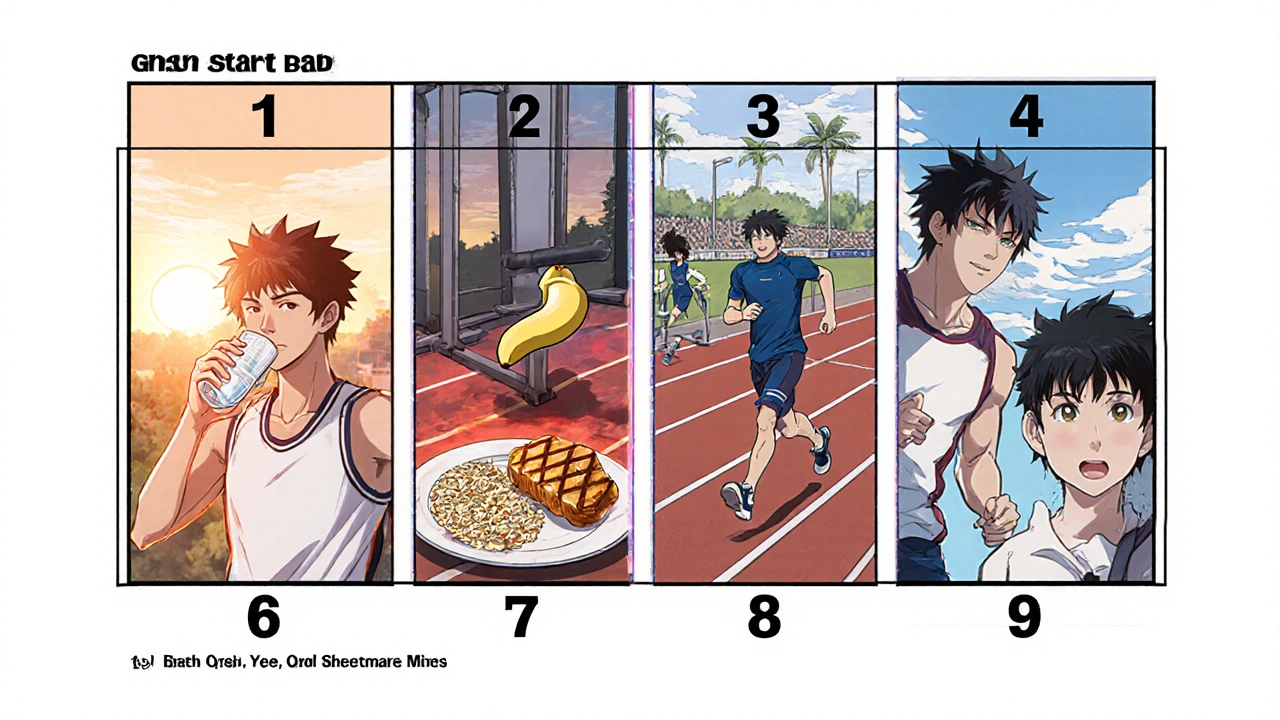Heartburn Trigger Checker
Check Your Pre-Exercise Habits
Identify potential heartburn triggers based on your meal timing and food choices
Enter your meal timing and activity details to see potential heartburn triggers
When a burning sensation in the chest shows up right before a race or a weight‑lifting session, the last thing an athlete wants is to lose focus. Heartburn is a symptom of gastro‑esophageal reflux, where stomach acid climbs up the esophagus and irritates the lining. For athletes, that discomfort can drop stamina, mess with breathing, and even trigger anxiety. Below you’ll find a step‑by‑step plan that pulls together medical basics, nutrition tweaks, and training tricks so you can keep the burn out of the way and stay at peak performance.
Quick Takeaways
- Identify personal trigger foods and timing - most athletes notice problems when they eat 1‑2hours before intense activity.
- Choose low‑acid, protein‑rich meals and stay hydrated with water or non‑carbonated drinks.
- Use short‑acting antacids for immediate relief, but rely on H2 blockers or proton pump inhibitors for long‑term control.
- Strengthen core muscles and practice diaphragmatic breathing to reduce intra‑abdominal pressure.
- Manage stress through mindfulness or yoga; stress hormones can worsen acid reflux.
Understanding the Physiology
During high‑intensity activity, the diaphragm contracts harder, and the abdominal cavity gets squeezed. This pressure pushes stomach contents upward, especially if the lower esophageal sphincter (LES) is weak. Gastroesophageal Reflux Disease (GERD) is the chronic form of this issue. In athletes, even a temporary LES relaxation can cause symptoms that feel like heartburn, chest tightness, or a sour taste.
Spot Your Triggers
Every body reacts differently, but studies of endurance runners show a pattern: the most common culprits are caffeine, spicy food, carbonated beverages, and large meals eaten less than two hours before training. Keep a simple log for two weeks - note the time you ate, what you ate, the type of workout, and any reflux symptoms. Over time you’ll see a clear picture.

Nutrition Strategies for Acid‑Free Performance
- Timing is key. Aim to finish your main Pre‑Exercise Meal at least 90 minutes before a high‑intensity session. If you need a quick snack, choose bland carbs (like a banana) and a small amount of protein.
- Choose low‑acid foods. Opt for oatmeal, whole‑grain toast, non‑citrus fruits, and lean poultry. Avoid tomatoes, citrus, and vinegar‑based sauces close to training.
- Watch the caffeine load. A cup of coffee before a morning run can be fine, but for many athletes moderate caffeine (<200mg) reduces the risk of reflux.
- Stay away from carbonation. Sparkling water may feel refreshing, but the bubbles increase intra‑abdominal pressure, pushing acid up.
- Hydrate smartly. Water and electrolyte drinks without added sugar or citric acid keep the stomach empty and dilute acid.
Medication Options - When to Use Them
Most athletes can control heartburn with diet and training tweaks, but occasional flare‑ups call for medication. Below is a quick comparison.
| Option | Onset | Duration | Typical Use | Key Considerations for Athletes |
|---|---|---|---|---|
| Antacid | 5‑10min | 1‑2h | Immediate symptom relief | May contain calcium or magnesium - watch for GI upset before competition |
| H2 Blocker | 30‑60min | 6‑12h | Short‑term control (e.g., day of a tournament) | Generally safe, minimal impact on performance |
| Proton Pump Inhibitor | 1‑2h | 24h+ | Long‑term management (daily use) | May affect nutrient absorption (e.g., B12, magnesium) - monitor with a sports dietitian |
| Lifestyle changes | Varies | Continuous | Core strengthening, breathing technique, stress control | No side‑effects, improves overall performance |

Core Strengthening & Breathing Techniques
Strengthening the muscles that support the spine and abdomen can keep the LES in a better position. A simple routine that many elite runners use includes:
- Plank variations - hold for 30‑45seconds, 3 sets.
- Dead‑bugs - 12 reps per side, focusing on a stable spine.
- Hip bridges - 15 reps, squeeze glutes at the top.
Pair these moves with diaphragmatic breathing: inhale through the nose, let the belly expand, then exhale slowly through pursed lips. Practicing this for 5 minutes before warm‑up can lower intra‑abdominal pressure and reduce reflux episodes.
Stress Management for the Competitive Mindset
Stress spikes cortisol, which can relax the LES and increase acid production. Incorporating mental‑training tools helps both performance and digestion. A few easy habits:
- Five‑minute mindfulness breathing after every training session.
- Progressive muscle relaxation on rest days.
- Journaling pre‑competition to offload worries.
When stress is under control, heartburn frequency often drops dramatically.

Putting It All Together - A Sample Day Plan
Below is a realistic schedule for a mid‑distance runner who wants to avoid heartburn before a 10km race.
- 06:30am - Wake‑up: 250ml water, 5‑minute diaphragmatic breathing.
- 07:00am - Breakfast: Oatmeal with banana, a scoop of whey protein, and herbal tea (no caffeine).
- 08:30am - Light snack (if needed): Plain rice cake with almond butter.
- 09:30am - Core routine: Plank, dead‑bugs, hip bridges (total 12minutes).
- 10:00am - Warm‑up: Easy jog + 5‑minute mindfulness breathing.
- 10:30am - Race: If heartburn appears, a chewable antacid can be used immediately; otherwise, continue.
- 12:00pm - Post‑race meal: Grilled chicken, quinoa, steamed veggies, and water.
- Evening: H2 blocker if reflux symptoms persisted during the race; stretch and journal about any discomfort.
Adjust timing based on personal schedule, but keep the 90‑minute gap between larger meals and intense effort.
Frequently Asked Questions
Can I take antacids right before a competition?
Yes, a chewable antacid works within 5‑10minutes and won’t impair performance, but avoid large doses that could cause stomach cramping.
Are proton pump inhibitors safe for long‑term use in athletes?
They are effective for chronic GERD, but because they can affect magnesium and B12 absorption, athletes should have periodic blood tests and balance with a diet rich in these nutrients.
What foods should I avoid on training days?
Common triggers include caffeine, spicy dishes, citrus, tomato‑based sauces, chocolate, and carbonated drinks. Test each one individually to see what affects you.
How does core strengthening reduce heartburn?
A strong core stabilizes the spine and keeps abdominal pressure evenly distributed, which reduces the force that pushes stomach acid up through a weak LES.
Is heartburn a sign of a more serious condition?
Occasional heartburn is common, but frequent episodes (more than three times a week) may indicate GERD, which should be evaluated by a healthcare professional.
Managing heartburn isn’t about a single quick fix - it’s a mix of smart nutrition, targeted medication, and training habits that keep the stomach’s pressure in check. By applying these tips, you’ll keep the burn at bay and let your performance shine.






Michael Dalrymple
October 17, 2025 AT 14:22From a coaching perspective, it is essential to view heartburn not merely as a discomfort but as a signal of physiological imbalance during training. By integrating diaphragmatic breathing drills, athletes can reduce intra‑abdominal pressure that typically forces acid upward. Moreover, timing nutrition to allow gastric emptying respects the body’s natural rhythms and preserves performance capacity. A holistic regimen that couples core strengthening with mindful stress reduction often yields more consistent results than medication alone. Ultimately, the athlete’s mindset should treat these adjustments as part of the broader quest for mastery.
Emily (Emma) Majerus
October 19, 2025 AT 08:02Totally agree with the breathing tip – it works wonders. Just watch that coffee sip before a run!!!
Katie Henry
October 21, 2025 AT 01:42Esteemed athletes, I commend your dedication to optimizing performance through evidence‑based strategies. The integration of low‑acid nutrition and structured core work exemplifies a disciplined approach. Please consider that consistency in these practices often manifests as incremental gains observable over successive training cycles. Your commitment to such precision will undoubtedly translate into measurable competitive advantages. Continue to pursue excellence with vigor and unwavering resolve.
Joanna Mensch
October 22, 2025 AT 19:22They don’t want you to know the truth about acid reflux.
RJ Samuel
October 24, 2025 AT 13:02Listen up, fellow athletes – the whole “avoid all caffeine” narrative is a bit of a spin, isn’t it?
First of all, caffeine is a stimulant that can actually enhance focus and perceived effort if you don’t overdo it.
Second, the timing matters more than the mere presence of caffeine – a modest cup an hour before a session is far less likely to trigger reflux than a massive espresso right before you sprint.
Third, the body’s acid production is a complex orchestra, and blaming a single ingredient oversimplifies the symphony.
Fourth, many high‑performing runners swear by a tiny dab of espresso as their secret weapon, and they’ve never reported chronic heartburn.
Fifth, if you’re truly suffering, the issue often lies in the size of the meal, not the caffeine itself – a gargantuan carb load will push the stomach wall up regardless of coffee.
Sixth, let’s talk about the “low‑acid” foods – tomatoes, citrus, and even chocolate are routinely labeled culprits, yet scientific studies show mixed results.
Seventh, it’s the combination of high‑intensity intra‑abdominal pressure plus a full stomach that is the real villain.
Eighth, athletes who incorporate gentle core activation and diaphragmatic breathing during warm‑ups report fewer reflux episodes.
Ninth, hydration with plain water or electrolyte mixes helps dilute stomach acidity, but over‑hydration at the wrong time can also be problematic.
Tenth, you can experiment with H2 blockers on training days, but rely on lifestyle tweaks for long‑term mastery.
Eleventh, keep a detailed log – like the post suggests – and you’ll see patterns emerge far clearer than any generic diet chart.
Twelfth, remember that the gut microbiome plays a role; fermented foods in moderation can actually soothe the esophagus.
Thirteenth, don’t forget the role of posture – slouching after a meal can exacerbate reflux, especially in weight‑lifters.
Fourteenth, mental stress amplifies acid secretion, so pre‑competition rituals that calm the nervous system are a win‑win.
Fifteenth, the occasional “cheat” meal is fine if you plan your training around it; the body is adaptable.
Sixteenth, in short: be smart about timing, portion sizes, core stability, and stress management – and you’ll keep that burn at bay while still enjoying your favorite pre‑workout brew.
Nickolas Mark Ewald
October 26, 2025 AT 06:42Great summary, thank you for the practical steps. I will try the 90‑minute meal window and add some core drills.
Chris Beck
October 28, 2025 AT 00:22Honestly these tips are stupid!!! You think a banana will fix heartburn??? No way... Just stop eating and run!!!
Sara Werb
October 29, 2025 AT 18:02Oh my gosh!! This is exactly what the elite athletes don’t want us to know!!! The “secret formula” is hidden behind these bland diet tips!!! Wake up!! Your stomach is being manipulated by big pharma!!!